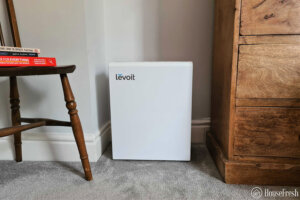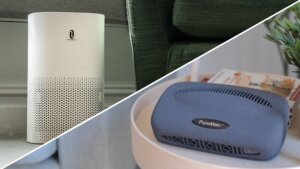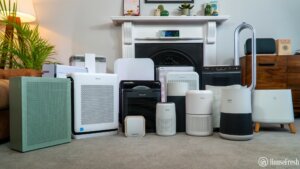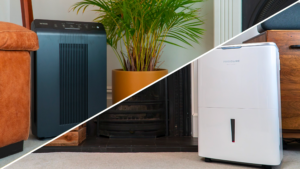The air quality in your home might not be as good as you think. Even with regular cleaning, harmful pollutants can sit undetected in your environment.
Whether you live in a polluted area (indoor or outdoor), suffer from allergies, reside in a smokey or dusty home, or simply want all the health benefits from uncontaminated air, an air purifier can help.
When you boil it down to the bare minimum, air purifiers are simply a fan attached to a filter. Contaminated air flows in and passes through the filter, removing the pollutants and leaving you with clean air. Of course, the units you buy in the stores are much more advanced than that, but the principle is the same.
The most effective air purifiers on the market are those that use HEPA filters to remove the microscopic particles that linger in the air. HEPA-grade filters contain a maze of tightly woven fibers that stop harmful pollutants from passing through. In addition to HEPA filtration, most units on the market also come with a pre-filter (to tackle larger contaminants like dust and hair) and an Activated Carbon filter (to remove odors and Volatile Organic Compounds).
But, should you buy an air purifier for every room in your house? Or would just one device do the job?
How to decide how many air purifiers you will need
Here’s the thing:
The right air purifier in the right spot will be able to clean the air in the largest of spaces. Units like the Blast Mini or the IQAir Healthpro Plus will do a great job across multiple rooms when leaving the doors open, as this test from the Smart Air team shows. But both those air purifiers come at a hefty price tag, and will be out of budget for most people.
So, with that in mind, let me give you some general rules of thumb:
- For those who live in a big house or who share their home with many people, having more than one air purifier ensures the air is clean throughout your house.
- If you are looking for an air purifier to help tackle a specific issue in a specific area of your home (e.g., cooking odors in the kitchen), then getting just one unit should be enough to improve the air quality in the room.
- When buying an air purifier for a classroom, an office, a waiting room or any other type of shared area, it’s important that you buy a unit that can deliver clean air in the room 4.84 times per hour.
If you cannot get more than one air purifier for your home, you can get a lot out of a single unit if you buy a high CADR air purifier and use it correctly:
1. Run your air purifier continuously
Most air purifiers are designed to run continuously throughout the day and night as long as you adjust the fan speed accordingly. Units don’t need to be set to maximum fan speed for extended periods; this is just a waste of energy and can be dangerous. Keep your purifier on a lower fan speed and turn it up when you need that boost (when cooking, when people are in the room, cleaning etc.)
2. Move your air purifier around
Most units are designed to be moved around; some even come with wheels and handles to make it easier. Take your unit around your home with you. Before you sleep, place it in your bedroom to ensure clean air throughout the night, move it into the kitchen when you’re cooking, or run it in the living room when you’re chilling out after a day.
The factors to consider before deciding how many air purifiers you need
The number of air purifiers you will need in your home isn’t a straight answer, as it comes down to different variables that will affect your specific home and situation.
1. How big is the space you want to purify
This is one of the main things you need to work out when buying an air purifier. If you get the wrong unit for the size of your space, it will either not clean the air effectively (if the unit is too small) or use a lot of energy to run and take up floor space (if the unit is too big).
Air purifier manufacturers know this information is essential, so (most of the time) they will tell you what size space the unit is designed for, usually measured in square feet. This can vary massively from unit to unit and doesn’t always follow a pattern of “the bigger the unit, the larger space it will clean.”
Before purchasing an air purifier, measure your space. Will the unit you’re looking at cover the area you have? Depending on these measurements, you may only need a single air purifier to cover your whole home, or you will need to run more than one to ensure the air is cleaned in each room.
CADR (Clean Air Delivery Rate) also plays a crucial role in how effective an air purifier will be in your home. CADR measures how much air a purifier can clean in a certain period. An air purifier with a high CADR is more efficient than a unit with a low CADR, which will have to work harder to clean your space.
The CADR (shown as CFM) is commonly found with the other unit specifications, so it shouldn’t be too hard to find. A good rule of thumb is:
- A home from 300 to 500 sq. ft. > One unit with a CADR of at least 150 CFM
- A home from 500 to 900 sq. ft. > One or two units with a combined CADR of 300 to 500 CFM
- A home larger than 1000 sq. ft. > Two or three units with a combined CADR of 600 CFM or higher
We have also created a handy calculator to help you figure out the CADR rating you should be looking for, depending on the size of the space:
If you want to know more about the importance of CADR, check out our page on what is CADR rating, where we delve further into the subject.
2. The number of people who live in your home
The more people coming in and out of your home, the more contaminants will be introduced to your environment, compromising your overall air quality (especially if doors and windows are continually open).
If multiple people are breathing the air, you will need either a unit with a high CADR, or more than one air purifier to cover different areas of your home:
- Kitchen
- Bedroom
- Living room
- Basement or attic
3. The issues that you want to resolve
As well as size and space, you need to consider why you need an air purifier in your home.
- Do you suffer from allergies?
- What is the source of contamination?
- Is your home dusty?
- Are you trying to reduce mold and mildew growth?
- Do you have pets that shed dander?
The more severe the issue is, the higher CADR a unit requires, or multiple units should be considered.
4. How sensitive you or your family are to noise
Every air purifier creates noise as its fan spins around to circulate air. Not all units produce the same sound level — it can range from between 20dB up to 60dB+, depending on the model.
If you prefer a quiet household or don’t wish to be disturbed by the sound of electrical devices making noise, you might want to consider only having one unit, as more units = more noise.
5. How good is air circulation in your home
One of the reasons you might need an air purifier is poor air circulation in your home. A purifier will use its fan to push clean air into your space while removing harmful pollution that isn’t being circulated in your environment.
This could be due to a lack of ventilation or the shape of your room(s). If this is the case, your home may benefit from multiple air purifiers concentrating on areas affected by poor air circulation.
6. Your budget available
I’ve added this for the obvious reason: if you don’t have the budget to purchase multiple units… don’t.
But have you also considered the extra costs that come with owning an air purifier? Air purifiers use electricity to run, and the amount of energy they use differs between models. This will affect how big or small your electricity bill will be.
As HEPA filters trap airborne pollutants, they become full and less effective over time, reducing the total airflow. This means they need to be replaced periodically, and every model has varying filter lifespans and replacement costs. You can clean a HEPA filter with a vacuum, but never use water as this will damage it.
Where should you place your air purifier?
Where you place your air purifier can make a big difference in how it performs. You should follow certain dos and don’ts to maximize the efficiency and effectiveness of your device.
Things you should do
Things you should avoid
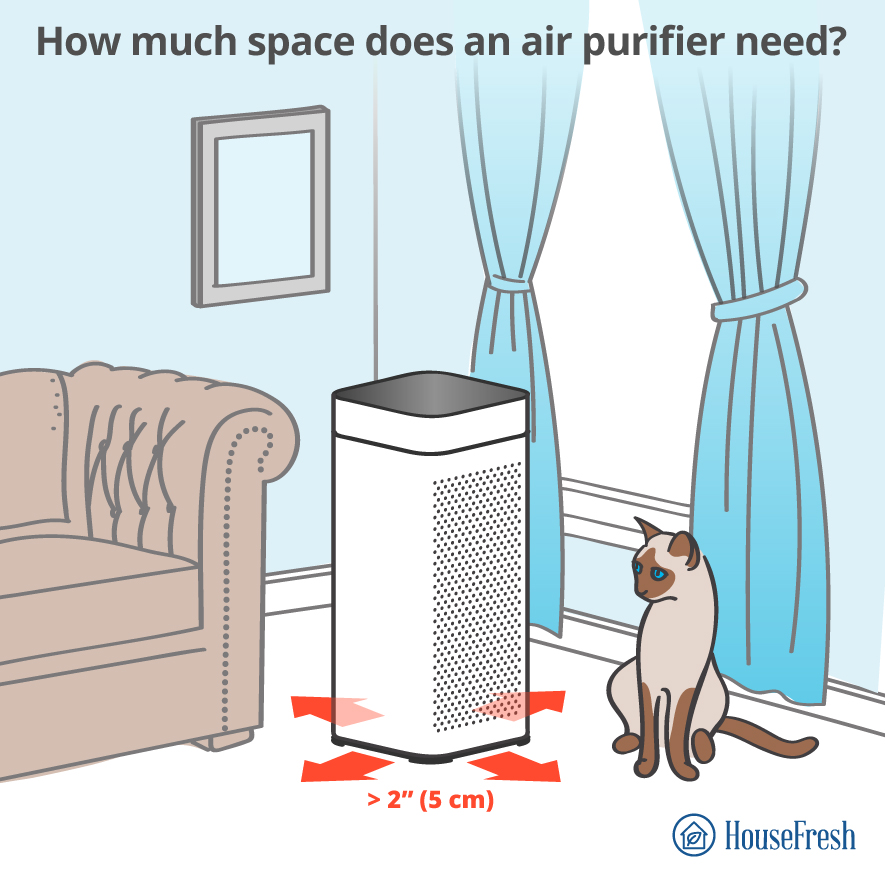
Final thoughts
Running an air purifier in your home provides many health benefits, like keeping the air you breathe clear of harmful pollutants and VOCs. When researching which air purifier is best for your home, you will notice many differences between the specifications of different models.
You must get the right unit to fit your space, so measure up first and determine what you need from that air purifier.
We can’t tell you exactly how many air purifiers you’ll need for your home, as all needs are different. Hopefully, these tips will guide you and provide insight into what to look for when deciding if you need an air purifier in every room.



